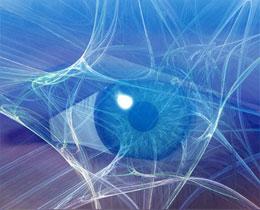Nature News | Zeeya Merali | 2011 Apr 28
Results of entanglement made visible to human eyes.
It's an eye test with a quantum twist: physicists have used humans to detect the results of a quantum phenomenon for the first time.
By linking a single photon to a field of thousands,
researchers have made the invisible visible.
(Credit: Equinox Imagery / Alamy)
Nicolas Gisin, a physicist at the University of Geneva in Switzerland, devised a new test to see if the human eye could pick out signs of 'entanglement'.1 This weird quantum effect inextricably links two or more objects in such a way that measurements carried out on one immediately change the properties of its partners, no matter how far apart they are. Quantum effects, such as entanglement, are usually confined to the invisible microscopic world and are detected only indirectly using precision instruments.
Gisin and his colleagues were inspired by an experiment carried out in 2008 by Fabio Sciarrino and his team at La Sapienza University in Rome, Italy.2 Usually, physicists working with entangled photons only deal with a small number at a time. In the Rome experiment, the physicists entangled a pair of photons and then 'amplified' one of them to create a shower of thousands of photons with the same quantum state. In this way, one 'microscopic' photon seemingly became entangled with thousands of others in a 'macroscopic' light field. "I immediately realized that the human eye could see that many photons," says Gisin.
Using a similar set-up to that of Sciarrino, Gisin and his team entangled two photons. One was sent to a standard photon detector, while the other was amplified using a machine that generated a shower of photons with the same polarization, thereby, in theory, generating a micro–macro entangled state.
But Gisin replaced the photon detector Sciarrino used for the light field with a human. The beam of light produced by the amplifier could appear in one of two positions, and the location of the beam reflected the polarization state of the photons in the field. Gisin and his team sat in the dark for hours, marking the position of the light spot over repeated runs of the experiment, for the first time seeing the effects of quantum entanglement with the naked eye.
Like Sciarrino's group, Gisin and his team used the standard test for entanglement, known as a Bell test, to compare how well the polarization of the single photon and the light field matched up. This test sets a level for the correlation of states between the two objects above which their entanglement is confirmed. And, like the Rome group, Gisin's team got a positive result.
The results of the human 'detectors' were checked with photon detectors, and they matched — although the latter were "faster and more reliable than humans and didn't complain of tiredness", Gisin says
More than meets the eye
But there was a hitch. What Gisin's team saw was not micro-macro entanglement. Gisin had a nagging suspicion that the Bell test may not be valid for macroscopic objects, so he deliberately set up the experiment so that the state of the second photon was measured before it was amplified. According to the rules of quantum mechanics, this act of measurement would break the entanglement, meaning that the first photon and the light field could not be in an entangled state. The system should not have passed the Bell test.
"We set up the worst kind of amplifier precisely to see what result the standard Bell test would give, and it gave the wrong — positive — answer," says Gisin.
The reason for the false positive result is that no detector — human or mechanical — is perfect, says Gisin. Some photons will always be lost during the experiment — an effect known as the detection loophole. Normally, this does not affect the Bell test, but Gisin says that as more photons come into play, the loophole hugely distorts the results. So regardless of whether or not Sciarrino and his team did create micro–macro entanglement in their 2008 experiment, the Bell test would always give a positive result, says Gisin.
"This is brilliant work showing that if we do not control everything in the experiment, we can be fooled into thinking we have seen a macroscopic quantum effect, when we haven't," says Magdalena Stobińska, a quantum physicist at the Max Planck Institute for the Science of Light in Erlangen, Germany.
Sciarrino is not surprised by the results. He and his team had already realized that they could not trust their Bell test, and are working on a new way to verify micro–macro entanglement. They plan to use a laser to boost the light signal from the photon field to improve its chances of detection.3 "Unfortunately, we cannot do this experiment with humans as detectors because the laser would burn out their eyes," Sciarrino says.
Even though Gisin's team did not see micro-macro entanglement, he notes that the positive Bell test does show that the original pair of single photons was entangled before amplification, confirming micro-micro entanglement existed at the start of the experiment.
"The experiment is lovely because in this sense you can 'see' entanglement," says Sciarrino. "It brings quantumness closer to human experience."
- Experimental amplification of an entangled photon: what if the detection loophole is ignored? - E Pomarico et al
- arXiv.org > quant-ph > arXiv:1104.2212 > 12 Apr 2011
- Entanglement Test on a Microscopic-Macroscopic System - F De Martini, F Sciarrino, C Vitelli
- Physical Review Letters 100 253601 (27 Jun 2008) DOI: 10.1103/PhysRevLett.100.253601
arXiv.org > quant-ph > arXiv:0806.2218 > 13 Jun 2008
- Physical Review Letters 100 253601 (27 Jun 2008) DOI: 10.1103/PhysRevLett.100.253601
- Hybrid non-locality test in a microscopic-macroscopic system - N Spagnolo et al
- arXiv.org > quant-ph > arXiv:1012.3660 > 16 Dec 2010

